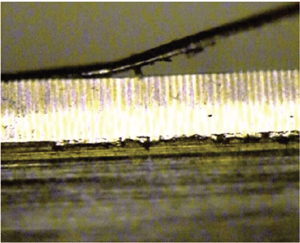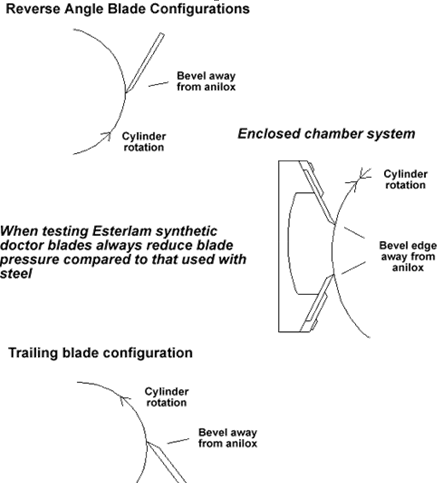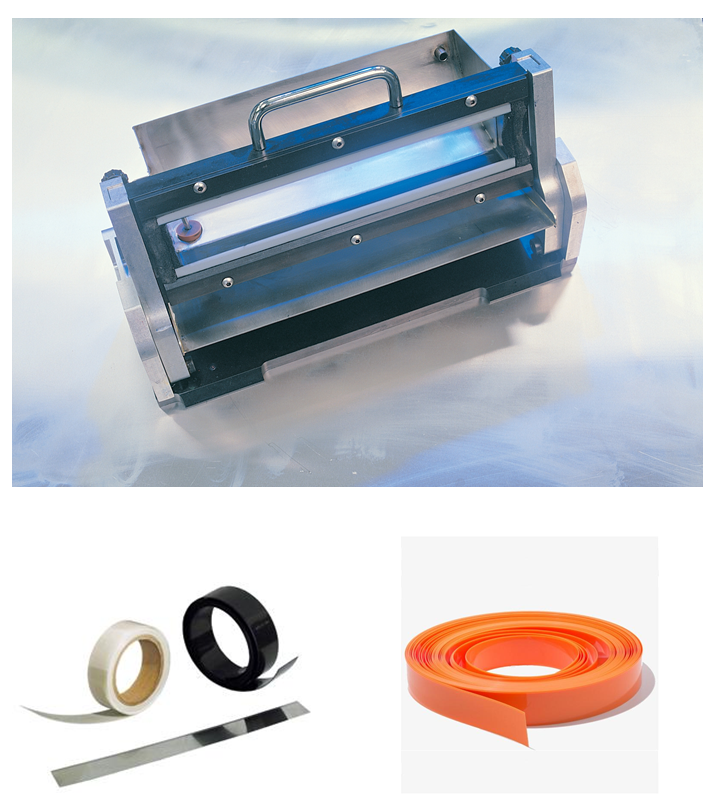Anilox scoring seems to be a never-ending challenge: it can occur immediately at start of a new production run, other times it can appear suddenly, and other times it comes and goes. Yet it never seems to totally go away.
In THIS ARTICLE WE WILL COVER THE FOLLOWING:
- What is anilox scoring?
- Why does anilox scoring occur?
- Doctor Blade Selection
- Steel v Synthetic v composite
- How to minimize anilox scoring.
Regardless of the level of pressroom knowledge, anilox scoring can rear its head and if left unchecked it can become very expensive. Firstly in replacing the anilox and then the time and material cost because of the spoiled production.
WHAT IS ANILOX SCORING?
Anilox scoring is visible as thin circumferential lines on the surface on the anilox roll which quickly show up on the print surface. When foreign particles become trapped between the doctor blade and the anilox, it is likely that the finely engraved cells within the anilox will become blocked, damaged, or even destroyed. Small particles do circulate in the inking system and are usally harmless, however when these particles become trapped they can accumulate, harden and then eventually destroy the ceramic engraved cells. Although ceramic is an extremely wear-resistant metal oxide material, it is far from flexible or impact-resistant.
There are two main types of score lines: deep gouging and light polishing. Deep gouging score lines initially appear as dark streaks and quickly change to light streaks as the doctor blade wears into the anilox. Light polishing score marks are the most common and also show up as light streaks in the printed area. Light streaks are the result of a change in the cell walls of the engravings and a reduction in height resulting in less ink volume in damaged cells. A common misconception is that all streaks are score marks, but that is not so. 'Fill-in lines' also referred to as 'pick-up lines' are a group of cells that have become plugged with dried ink residue. Ink residue builds up and eventually gets ground into the anilox cells. The plugged cells contribute to a loss of volume in that area of the anilox roll, this then consequentially results in a loss of ink transfer to the polymer which is visible as light streaks on the printed substrate. Plugged cells can be easily cured through ultrasonic cleaning of the Anilox Roll on a regular basis.
WHY DOES ANILOX SCORING OCCUR?
The primary culprit of anilox score lines is the steel doctor blade, as the doctor blade wears away the tip becomes very fine and can break off in various sizes of wire-looking metal shavings called “Slivers” (see photo on page 2). Under normal setup, doctor blades should wear by shedding microscopic levels of metal particles that are consumed in the chamber system or extracted by the magnets in the ink filtration system. However, large slivers of metal can often get into the ink system when there is excessive pressure on the doctor blade. Excessive pressure forces the doctor blade backward and changes the contact angle away from the tip.
This change in pressure wears the blade in a location which will ultimately cause long tip to break into slivers. Within an ink pumping fillter system these slivers can be filltered out , but if not the slivers eventually get back into the chamber and become embedded at the back of the doctor blade against the anilox roll; & can at worst result in a permanent “score line”.
Overhanging doctor blades; those that hang past the end of the anilox roll can contribute to leaking, which in turn usually leads to additional doctor blade pressure in an effort to minimize the leaking. Excessive pressure will contribute to the wearing of a deep groove in the doctor blade where it overhangs and that can cause large particles to wear off. It is best to keep the ends of the blades as flush with the ends of the anilox roll as possible to minulmise this effect.
Additional culprits are the overuse of doctor blades, contaminants in the ink system, misaligned chambers, excessive chamber pressure and rough anilox surfaces. Over used doctor blades require excessive pressure; excessive pressure leads to doctor blade slivers, and thus the undesirable cycle continues. Contaminants can make their way into the ink system in many different ways. If the mixer is allowed to bottom out against the drum or metal bucket, it will generate metal shavings and flakes. The metal pads or metal scrapers used in cleaning can generate metal shavings that cling to the frames of the
chambers and once back on the press, make their way into the ink system. Cleaning rags or roll covers are sometimes contaminated with metal particles and when they come in contact with the anilox roll, the particles get back into the ink system.

Above: Magnification of a deep score on the edge of a doctor blade

Above: Slivers of metal online on the surface of an anilox role
Ink chambers will not always hold their alignment, so they should be checked on a regularly scheduled basis. Misaligned chamber frames can rub against the anilox roll and the worn particles will go directly into the ink system. Inspect the doctor blade clamp frame nearest to the anilox roll; if there is a groove the same length as the anilox roll, chances are there will be scoring. The common way to compensate for a misaligned chamber is to add more pressure.
Another factor can be the surface of the anilox roll; if the surface is not properly prepared and the cell walls have excessively uneven heights, the ceramic can be sheared off and make its way into the ink system - or it can shear parts of the doctor blade and these particles eventually collect behind the doctor blade, causing a score line. Anilox rolls with chipped ends can also contribute to scoring, especially if parts of the chips are sheared off by the doctor blade, or the doctor blade is worn off in chunks, adding metal particles to the ink system. A good cardinal rule is to never rotate a dry anilox roll against the doctor blade.
DOCTOR BLADE SELECTION:
Trail Doctoring vs. Reverse Angle
To make intelligent choices we need to first understand the difference between these two systems. The major difference is that a trail doctoring blade scrapes the ink, while a reverse angle blade shears it off the anilox surface. Lets take a closer look!

Trail doctoring (sometimes called forward doctoring) is still the predominate way of doctoring in the gravure industry. The doctor blade is at an acute angle from its tangential line of contact and it scrapes the ink off the roller’s surface. To make it simpler it looks more familiar in a press setting. As we look at the diagram this will leave a lubricating ink film on the roller, extending blade life. Because of the nip or hydraulic pressure created by the excess ink the blade will float with increased press speed. To adapt for this blade pressure is turned up. A stepped blade is most often used in this application.
Reverse angle doctoring is the dominate system in the flexographic industry. In this method the ink is sheared off the anilox roll surface at an obtuse angle from the tangential line of contact. Simplified in the press schematic, This gives us a more consistent ink film thickness by shearing the ink from the top of our laser engraved ceramic cells. Press speed has less of an effect on the ink film thickness. With less ink film, blade life is much shorter and effects roller wear. There are many reasons for different metering tips and minimal blade pressure is our goal.

STEEL vs SYTHETIC vs COMPOSITE BLADES:
Advantages of carbon steel are that you have one of the strongest spring strengths available and you can run a thinner blade to achieve the wipe you want. However always be sure you are receiving quality steel if you want to avoid expensive damage to your Anilox Roll through scoring. If corrosion of your blades is a problem stainless steel is available. These blades are of a softer material and usually wear faster than the carbon steel on ceramic. These are used most often on chrome anilox rolls to help reduce wear to the roll. To check and see if your current blades are stainless steel put a magnet to them to see if it sticks. Stainless steel does not have an attraction to magnets. Blade life has been improved by the introduction of plastic blades. To get the spring strength and wipe comparable to steel, these materials are made of a heavier gauge and would need a reduced edge. These materials are most used on the containment side of enclosed doctor blade systems. Another reason for these blades is their resistance to corrosive materials such as high titanium whites and some coating materials being used. Safety is another advantage to these blades as you are less likely to cut yourself during installation and cleanup. Composite blades offer us a combination of both worlds, but with a price premium. These blades are being developed with improved spring strength. This offers us the chance to make them out of thinner raw material (currently some as thin as .025 with a reduced edge of .010 with a stepped metering tip). It also allows the safety, longer life of plastic, and the corrosive protection needed. There have been much advancement in this area as technology of combined materials moves forward. The path forward... composite or synthetic blades have made more changes in this area of flexo than any of the others.
HOW TO MINIMIZe ANILOX SCORING.
The best way to minimize anilox scoring is a good care and maintenance program that includes the anilox roll, the chamber system, the ink department, the parts cleaning department and the pressroom environment. Additionally, adopt and maintain sound operational practices. Establish a checklist as part of your operation that includes the following:
- Keep aniloxes clean: establish scheduled, verifiable cleaning of anilox inventory. Anilox rolls should be inspected for cleanliness and if they need attention, they should be cleaned as soon as possible. Use an ultrasonic cleaning system monthly.
- Fix aniloxes with chipped ends: Chipped ends will wear chunks of metal particles from the doctor blade and they will go into the ink system.
- Select a good quality doctor blade: Steel, Stainless, Synthetic or Composite
- Establish monthly Ink Fountain maintenance: Check chambers for vertical and horizontal alignment. Check doctor blade assemblies are functioning correctly, springs changed if defective.
- Keep ink Fountain fittings cleaned: As part of the monthly maintenance program.
- Keep chambers aligned: Use a 0.005" plastic feeler gauge to test contact of the upper and lower blades to the anilox roll. Do this without the installation of end seals.
- Establish a schedule: For changing doctor blades based on the amount of wear.
- Establish practices to minimize excessive chamber loading pressure: Change seals when leaking starts, change blades on a regular schedule and select the correct anilox roll for the right color instead of adding additional pressure to achieve colour.
- Reset the chamber pressure when changing to a new doctor blade: Unless adjusted, the chamber pressure will be set for a worn doctor blade and with a new blade the excessive pressure will quickly create metal slivers in the ink system.
- If 'stops' are available on your stations, use them: This will prevent the chamber from contacting the anilox roll
- Keep pumps in good operating condition. And check filters are fitted where available.
- Select the correct doctor blade tip for your application.
- Always tighten doctor blades by starting from the center and going out.
- Cut doctor blades to correct length: Doctor blades hanging over the length of the anilox roll will contribute to end seal leakage and will wear a deep groove on the contact area on the overhang.
- Keep the press area clean!
The last point - 'keep the press area clean' - will reflect the totality of your work environment and work ethic. A clean pressroom area is almost always a reflection of a well-maintained production area. Adopting and maintaining good practices throughout your pressroom will help minimize scoring issues. Ongoing training and verification of proper procedures is imperative, especially when there is an employee change. Frequently when experienced staff members move up or move out, the value of care and maintenance practices is lost. Make those practices a part of your standard operating procedures and part of an ongoing training program.
Scoring can be a costly challenge if left unchecked. Hopefully the issues covered in this article will help to minimize that challenge, and provide you with enough Information to determine and fix the source of any scoring issues you may encounter.








